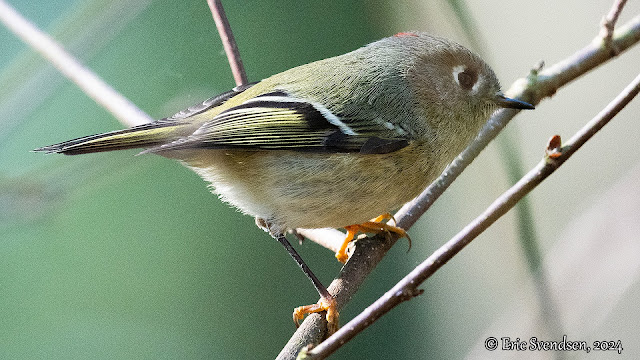Photographing birds with a 1.4x teleconverter
 |
| Spotted Towhee photographed today in Langley, BC. |
I have had my Nikon 500 mm PF lens now for a few years and I love it. The unfortunate thing about photographic equipment (in fact, stuff in general) is that you eventually want more. There was a time when I thought 300 mm was awesome, but then I got my 80-400 zoom and was enthralled by that. Most recently the 500 mm has been the apple of my eye, that is until the 800 came out.
Nikon's 800 mm PF lens only comes in a Z mount, which means that my D500 DSLR camera would not be a functional option; I would have to use a Nikon mirrorless camera for it to work. It is also very expensive, about $10 a millimeter, and requires deeper pockets than what I possess. But then I read about Nikon's new TC14-III, a 1.4x teleconverter that magnifies the image by 40% at the cost of one stop of light.
 |
| Wood duck photographed in Abbotsford yesterday. |
The reviews on it were very good. I have owned numerous teleconverters over time and have always found that the loss in quality and light compromised the image too much. However, I have never used a 1.4x teleconverter and Nikon seems to have come up with a winner. I have been using it now for about three months but haven't field tested it much as winter isn't the best time to practice my birding skills.
The nice thing about the teleconverter is that my 500 now has the equivalent focal length of a 700 mm with a minimum aperture of f/8. While the lower focal length and smaller aperture do not compete effectively with the 800 mm I have been drooling over, it also is about 1/12th the cost. Is it possible that the quality would be acceptable given the significant cost savings?
 |
| Ruby crowned kinglet photographed today in Langley, BC. |
I can honestly say that the extra magnification the teleconverter provides is significant. I can produce very good images of birds without having to crop to the same degree as before. It seems to me that cropping less compensates for any image quality lost because of the extra glass from the unit. If I could take a photo of the same scale without using the TC, I have no doubt that it would be better optically. However, that is hardly the point as birds rarely let you get that close to them.
The one-stop loss of light is a different story. It means either risking blur from camera motion blur or shooting at a higher ISO to achieve the same compensation from the lens' vibration reduction. I found myself shooting at ISOs between 400 to 3200 where I normally was shooting with an ISO of 200. Again, there is the fact that less cropping means keeping noise small, so I have to give points to the system for that.
 |
| Killdeer photographed today in Langley, BC. |
I think that having the TC outweighs not using one at all. I can revert to my 500 mm lens without the magnification boost and, if I need a little more punch, attach the teleconverter when needed. I am not fond of removing my lenses in the field, but given the options and associated costs, it seems to be the best plan. Using the TC when needed instead of as an always-on attachment makes a lot of sense. It's kind of like having a 500-700 mm zoom, albeit one with an inconvenient zooming mechanism. When in the field I like to bring the TC's end caps so I can keep its interior surfaces clean when not in use.
I am looking forward to testing it out more as spring finally arrives and summer comes. I will let you know what the final verdict is.
Thanks for reading,
Eric Svendsen www.ericspix.com



Comments
Post a Comment